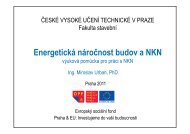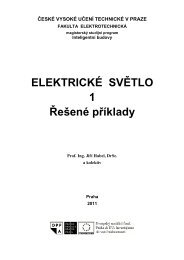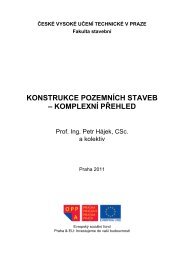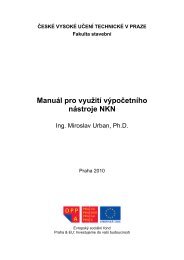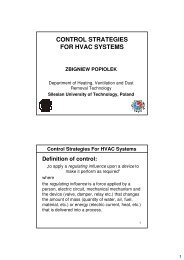Buses, Protocols and Systems for Home and Building Automation
Buses, Protocols and Systems for Home and Building Automation
Buses, Protocols and Systems for Home and Building Automation
You also want an ePaper? Increase the reach of your titles
YUMPU automatically turns print PDFs into web optimized ePapers that Google loves.
Evropský sociální fond. Praha & EU: Investujeme do vaší budoucnosti.<br />
- GB/T 20299.4-2006. St<strong>and</strong>ardization Administration of China Digital Technique<br />
Application of <strong>Building</strong> <strong>and</strong> Residence Community<br />
- SEMI E54.16. Semiconductor equipment manufacturers st<strong>and</strong>ard <strong>for</strong> sensor-actuator<br />
networks<br />
To support the protocol <strong>and</strong> the st<strong>and</strong>ards, an association called LonMark was founded. It<br />
has more than 400 members <strong>and</strong> it maintains the st<strong>and</strong>ards <strong>and</strong> the interoperability of<br />
devices. Besides companies like ABB, Honeywell, Thermokon, Shneider, Somfy or WAGO,<br />
LonWorks devices are also produced by Czech companies e.g. ZPA or ATD. Today, we can say<br />
that the plat<strong>for</strong>m is more popular in North America than in Europe, where the leader on the<br />
market of building automation is KNX.<br />
The LonWorks plat<strong>for</strong>m is focused mainly on the automation <strong>and</strong> field level of the<br />
hierarchical model. The system is based on a completely decentralized peer-to-peer net of<br />
smart nodes (Neuron chips). Every Neuron chip has a 48-bit unique serial number, which is<br />
very important <strong>for</strong> the identification in an installation. The dependency on a proprietary<br />
Neuron chip, which is the heart of every LonTalk device, is the most important disadvantage<br />
of the plat<strong>for</strong>m. This chip (developed with the companies Toschiba <strong>and</strong> Motorola) is based<br />
on three 8-bit processors, where two are dedicated <strong>for</strong> the protocol itself <strong>and</strong> the third one<br />
<strong>for</strong> the application:<br />
CPU1 – Medium Access Control<br />
CPU2 – Dedicated to processing Net variables<br />
CPU3 – User application programmed in a language called “Neuron C”<br />
The communication between nodes is realized by a logical linkage of network variables.<br />
Every device has a set of inputs, outputs <strong>and</strong> configuration network variables. These<br />
variables can only be of a type defined in the st<strong>and</strong>ard – the st<strong>and</strong>ardized types are called<br />
SNVT (St<strong>and</strong>ard Network Variable Types). Every SNVT contains some specific properties, e.g.<br />
upper/down limit. So, <strong>for</strong> example, if a thermostat wants to read a temperature from some<br />
sensor, then a virtual logical linkage between an output variable of the sensor <strong>and</strong> an input<br />
variable of the thermostat has to be created (the variables have to be of compatible type).<br />
One output variable can have a linkage with more than one input variable. This is a little bit<br />
different from the approach of the KNX, where the interconnection of input/output variables<br />
of devices is created by a group address of some st<strong>and</strong>ardized type. Measured values can be<br />
sent automatically in the case of some percentage change (analog variables), state change<br />
(binary variables), in some specified time intervals (using timer) or after some explicit<br />
request from another device.<br />
The LonTalk protocol can use one of six physical layers <strong>for</strong> transferring its data:<br />
- Twisted pair (common)<br />
- Power line 230V (common)<br />
- Radio frequency<br />
- Infrared<br />
- Coaxial cable<br />
- Fiber optics<br />
One of the newer features of Lon is LonTalk over IP or so-called IP-tunneling, which is very<br />
popular. There exists a special transceiver <strong>for</strong> every physical layer which is trans<strong>for</strong>ming<br />
physical layer specific signals to st<strong>and</strong>ardized input signals <strong>for</strong> the connected Neuron chip.<br />
The LonWorks plat<strong>for</strong>m can manage almost every task <strong>and</strong> wish in building <strong>and</strong> home<br />
automation (BMS) from room temperature control to security <strong>and</strong> access control systems.<br />
Ondřej Nývlt - <strong>Buses</strong>, <strong>Protocols</strong> <strong>and</strong> <strong>Systems</strong> <strong>for</strong> <strong>Home</strong> <strong>and</strong> <strong>Building</strong> <strong>Automation</strong> 17




